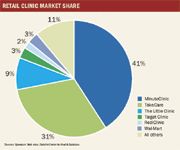Retail clinics on hit-or-miss trajectory
Clinic openings slowed from 350% growth in 2007 to 30% in 2008

There are currently more than 1,100 retail health clinics in the United States offering non-urgent healthcare services in pharmacies and grocery stores.
Between July 2008 and July 2009, the number of operators increased nearly 40%, including the entry of acute care organizations via contractual arrangements with drug store and grocery chains. In addition to the six largest players in the market, more than 50 organizations now operate nearly 140 clinics, claiming 11% of the market.
Clinic openings slowed from an astounding 350% growth rate in 2007 to 30% in 2008. During the first five months of 2009, the market contracted 5%, although the report forecasts modest growth for the year. Nearly 150 clinics closed in 2008. Although more than half of those were associated with smaller retail stores and startups, established operators likewise contracted.
RediClinic, which operated more than 50 sites in 2007, operated just 21 by mid-2009. CVS Caremark's MinuteClinics, which dominate the market with 451 sites, shed dozens of locations in stores not owned by the company and closed 104 underperforming clinics in the first two quarters of 2009, according to the report.
But don't read that trend as a retreat or as a direct effect of a recession, says Paul Keckley, executive director of the Deloitte Center for Health Solutions. Keckley says disruptive innovations in healthcare delivery rarely progress on a smooth trajectory.
For the most part, the report notes, retail clinics are modestly profitable and enjoy adequate patient volume. There's also increasing evidence that insurers are covering their services.
FORMULA FOR GROWTH
The pullback, Keckley says, "has been a decision by the hosts to really focus on refining the model to make it scalable."
For businesses accustomed to operating in the retail arena, that means refining business models to manage extended hours, liability and additional personnel costs. The hosts likewise need to determine exactly what range of services they'll provide in a scaled model. Most clinics offer a limited range, such as diagnosing upper respiratory infections and prescribing the appropriate antibiotic. Potential new services could include injection and infusion services, chronic disease management, smoking cessation and direct-to-employer insurance programs.
Keckley expects retail clinics to emerge from this "breather" period with more refined business models tailored to the type of host site-be it a pharmacy, supermarket, big box retailer or employer setting-where the clinic operates. He anticipates a second wave of cautious growth through 2011 followed by more accelerated growth through 2014 with the market topping out at about 4,000 clinics in 2015. Most of the growth, he says, will occur in suburban markets where clinic users would most likely have commercial insurance.
John Bigalke, national managing partner for Deloitte's health sciences practice, says the clinics could play an important role in providing healthcare for Medicaid recipients as well. As states grapple with providing primary care for the growing Medicaid population, retail health clinics may offer one way they can "continue to uphold their end of the social contract," he says.
Extending the Capabilities of the EHR Through Automation
August 2nd 2023Welcome back to another episode of "Tuning In to the C-Suite," where Briana Contreras, an editor of Managed Healthcare Executive, had the pleasure of chatting with Cindy Gaines, chief clinical transformation officer at Lumeon.
Listen